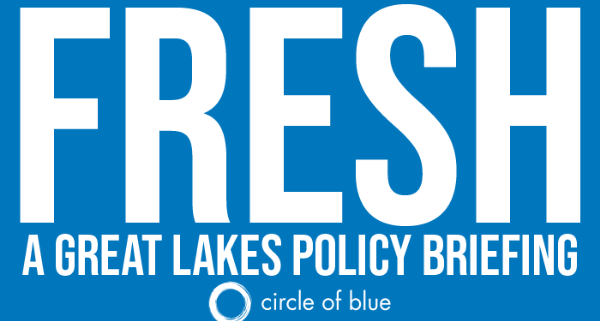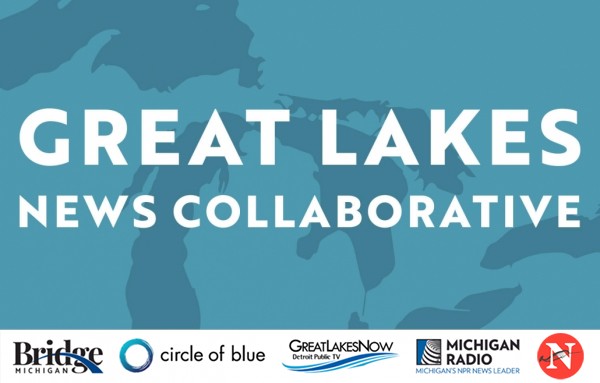Fresh, November 26, 2024: Enbridge Secures Permits for Pipeline Reroute, Putting Wetlands and Waters at Risk
November 26, 2024
Fresh is a biweekly newsletter from Circle of Blue that unpacks the biggest international, state, and local policy news stories facing the Great Lakes region today. Sign up for Fresh: A Great Lakes Policy Briefing, straight to your inbox, every other Tuesday.
— Christian Thorsberg, Interim Fresh Editor
This Week’s Watersheds
- Fourteen bipartisan members of Congress, from Michigan, Illinois, Wisconsin, and Minnesota, are leading an effort to oppose the burial of 50,000 tons of nuclear waste in the Great Lakes basin.
- The Wisconsin Department of Natural Resources issued key water and wetland permits to the energy company Enbridge, making way for a Line 5 reroute around Bad River lands.
- New research has found that neonicotinoid insecticides, for which the EPA currently has no safe drinking water levels, are pervasive in Minnesota’s shallow groundwater.
- The Great Lakes cruise ship industry is expected to generate $230 million in “economic impact” next year, a 15 percent increase from 2024.
Dozens of Michigan townships and counties are suing the state’s Public Service Commission over a renewable energy siting law that passed last year.
“The most important legal challenge for the renewables industry in America may have just been filed in Michigan.” — Jael Holzman, Heatmap News.
Last year the Michigan Public Service Commission passed Public Act 233, a renewable energy siting law which allows solar, wind, or other clean energy developers to bypass local governments — who in the past have sometimes slowed or denied projects — and go directly to the state with their proposals, Interlochen Public Radio reports. The law “gave the commission authority to approve large-scale renewable energy projects” at greater speeds, opening the door to rapid growth in the state’s renewable energy sector.
But some local governments have been upset by the act, saying it wrests power from them and ignores the desires of local constituents. In a lawsuit filed in early November, more than 70 Michigan townships and counties — a minority within the state, compared to its 83 counties and 1,200 townships total — are challenging not the law itself but the way it is executed, and the size of the projects under consideration.
Fresh from the Great Lakes News Collaborative
- Michigan House OKs tax breaks to lure Google, Microsoft data server farms — Bridge Michigan
- MI and OH: Different strategies to reduce Lake Erie nutrient pollution — Michigan Public
- I Speak for the Fish: How Native Americans are saving lake sturgeon — Great Lakes Now
- A dizzying bird’s-eye view of Manitoba’s hydro-electricity dams — The Narwhal
Bridge Michigan, Circle of Blue, Great Lakes Now at Detroit Public Television, Michigan Public and The Narwhal work together to report on the most pressing threats to the Great Lakes region’s water. This independent journalism is supported by the Charles Stewart Mott Foundation. Find all the work here.
Wisconsin DNR Issues Enbridge Water, Wetland Permits
The energy company Enbridge — whose Line 5 pipeline has been subject to formal litigation since 2019 for its infringement upon Bad River Band of Lake Superior Chippewa lands — has secured key permits needed to reroute part of its 645-mile oil and gas pipeline around the reservation, Wisconsin Public Radio reports.
Issued by the Wisconsin Department of Natural Resources, the permits will allow Enbridge to build a 41-mile detour which will see the 30-inch pipe run instead through Ashland and Iron counties.
As part of this new route, roughly 200 waterways will be crossed, 101 acres of wetlands will be temporarily disturbed, and 36 acres of wetlands will be “permanently cleared.” About a quarter of these wetlands have been classified to be of “high” or “exceptional” value for both water quality and flood protection.
“I’m angry that the DNR has signed off on a half-baked plan that spells disaster for our homeland and our way of life…We will continue sounding the alarm to prevent yet another Enbridge pipeline from endangering our watershed,” said Bad River Band Chairman Robert Blanchard in a statement.
The permits include more than 200 conditions Enbridge must meet to ensure water and wetlands health standards. If the company violates the permits or causes any spills, they must alert the DNR within 24 hours. They are also required to limit blasting within the wetland ecosystem, and have their work overseen by independent environmental monitors.
In the News
Nuclear Waste Burial: Fourteen bipartisan members of U.S. Congress — representing Michigan, Illinois, Wisconsin, and Minnesota — are urging fellow House and Senate members to oppose the Canadian Nuclear Waste Management Organization’s “plan to bury 50,000 tons of high-level nuclear waste hundreds of feet underneath the Great Lakes basin,” WCMU reports. Two sites are reportedly being considered: “one in Ignace, Ontario, about 155 miles north of Lake Superior, and another in South Bruce, Ontario, around 25 miles east of Lake Huron.” The U.S. lawmakers fear that this method of disposal could put Great Lakes waters, wildlife, and communities at risk of contamination, and are advocating for an alternative solution.
Neonicotinoid: A new study from the University of Minnesota and the state’s Department of Natural Resources found that neonicotinoid insecticides — a common class of insecticides most often applied to seeds before they are planted — are common and concentrated in in Minnesota’s karst areas. This landscape is “‘where you have high connectivity between the surface water and the groundwater,’” University of Minnesota professor Bill Arnold told Minnesota Public Radio. The EPA currently has no established safe drinking water levels for neonicotinoid insecticides.
Looking Ahead
Cruise Ships: The industry is expected to generate $230 million within the Great Lakes region in 2025, a 15 percent forecasted increase from 2024, Michigan LIve reports. Between six cruise lines, roughly 22,000 passengers are estimated to make 700 port visits — a 30 percent annual increase.
Upcoming Events
December 4 — Let’s Talk Lake Superior: Invasive Species in Lake Superior — register here
December 19 — Adaptive Forestry for a Resilient Climate — learn more
Other News
Ontario’s Algal Bloom Grants: The newly unveiled Thames River Phosphorus Reduction Program has allotted $17.4 million in federal funding to incentivize farmers to take steps to curb agricultural runoff into Lake Erie, a major cause of harmful algal blooms. These steps include “soil testing, crop covering, erosion control, subsurface fertilizer placement, and reduced fertilizer use,” CBC reports.
Grass Carp: Officials from both Canada and the United States are working together to keep grass carp — one of four invasive species known generally as “Asian carp” — out of Lake Erie and Lake Ontario, the Narwhal reports.
Christian Thorsberg is an environmental writer from Chicago. He is passionate about climate and cultural phenomena that often appear slow or invisible, and he examines these themes in his journalism, poetry, and fiction.









Leave a Reply
Want to join the discussion?Feel free to contribute!